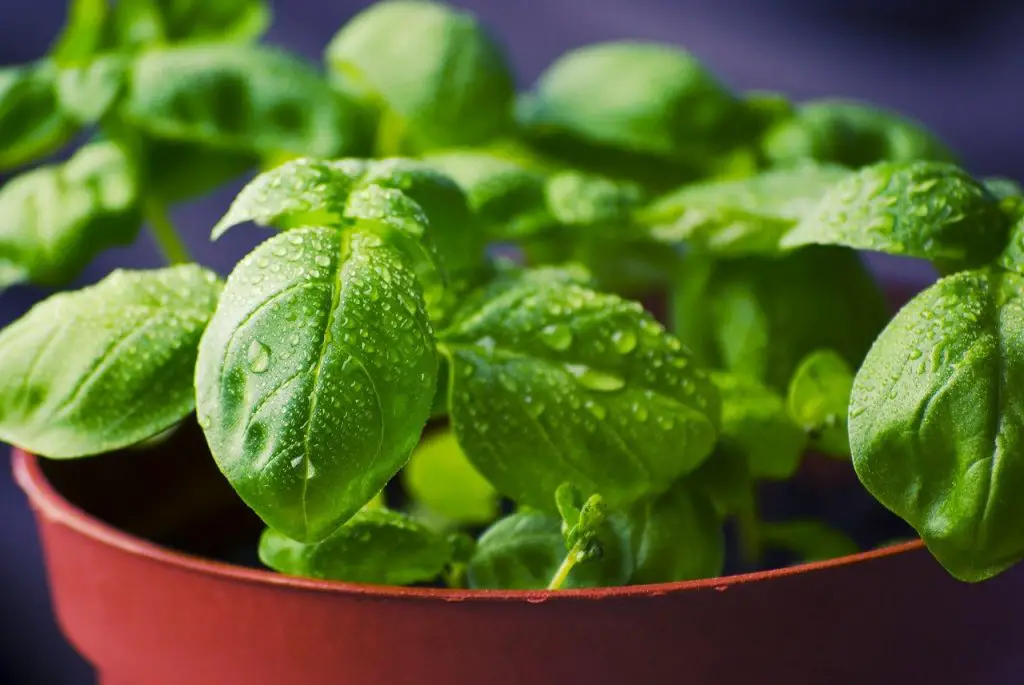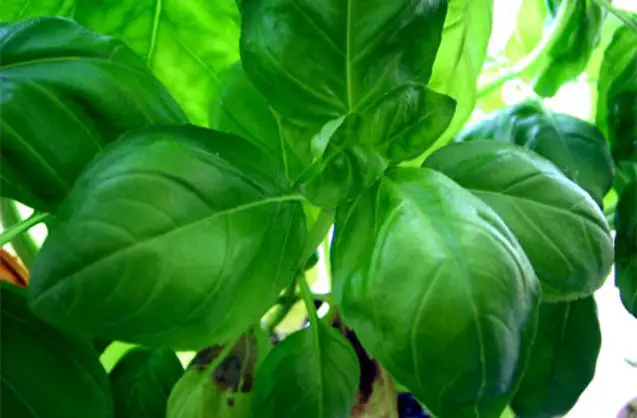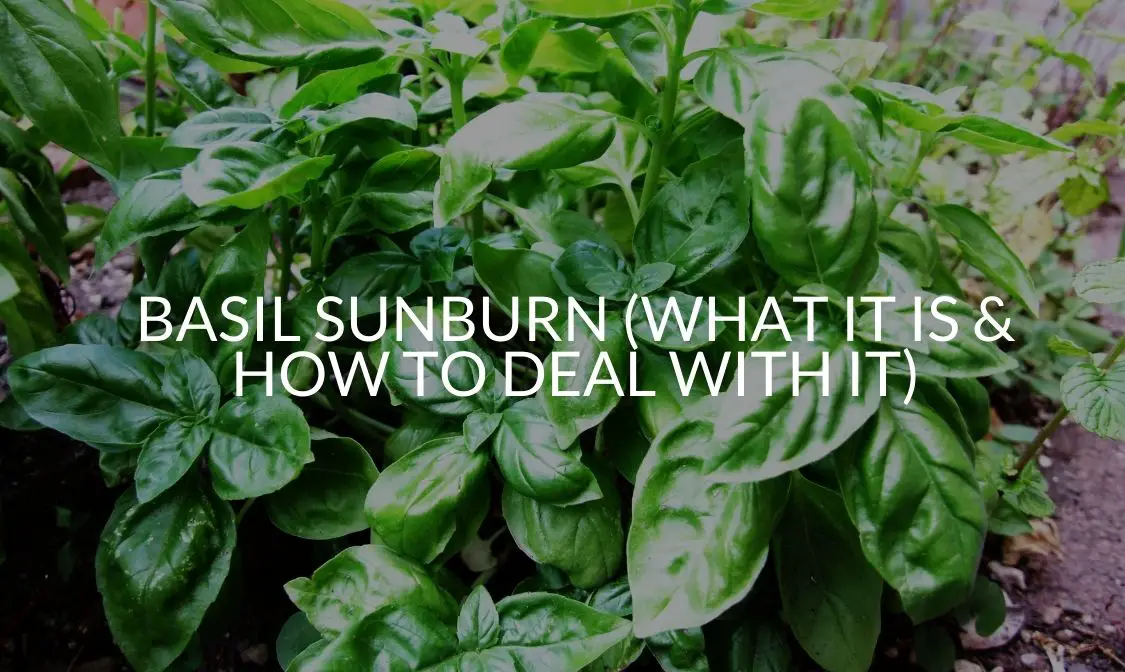Basil is one of the easiest herbs to grow, which makes it the one of the best things for beginners to start with. The one thing about basil is that it can’t stand cold soil, so you have to wait until the temperatures have warmed up until you bring it outside. If you plan accordingly, you should be able to grow a good yield of basil in the summer.
However, the weather that a basil plant needs to thrive poses one serious risk, that’s sunburn. This could happen to any basil plant, including the ones that you purchase at the store. Let’s take a look into basil sunburn and what you can do to prevent it.
What Is Basil Sunburn?
Sunburn isn’t just something that happens to people who don’t wear sunscreen. Even plants are susceptible to getting burnt from the sun. Basil sunburn occurs when the plant is exposed to too much sun and has not received enough water. This will likely cause the leaves to dry up and die off.
Can Basil Get Too Much Sun?
Basil plants will need anywhere from 6 to 8 hours of sun each day. If there is any area on your property where there is direct sunlight in the morning, and shade in the afternoon, then that is the ideal spot to grow basil. However, most cases of basil sunburn aren’t solely based on too much sun.
If a basil plant is receiving too much sun, then you can balance things out by making sure the plant gets enough water. It’s important to make sure they have well-draining soil, and you’ll need to water them frequently. These plants are extremely thirsty, so on a hot day they’ll need a bit of extra water.
Many gardeners have noticed that after many days in the extreme heat, their basil plants begin to look lively again after a few days in the rain. One of the most important things to stay on top of is giving your basil plant a sufficient amount of water during these sunny days.
When Is Basil Sunburn Likely To Occur?
Basil sunburn is likely to occur if the plant didn’t get enough time to develop its protective cuticle layer. When this happens the sun’s rays can get deep into the tissue of the leaves. To avoid this, you should transition the basil seedlings from indoors to outdoors gradually.
When you do this, the idea behind it is to get your plant used to the conditions it will be living in. Your indoor lights are completely different from the sun outside, so it will take a little bit for your plants to adjust. The best way to do this is by allowing them one hour of sunlight in the morning, then the next day to give them two hours.
Each day you can gradually give the plants more time in the sun until they are ready to be planted. After a week of getting the basil seedlings used to sunlight they should be ready to be planted outside.
What Are The Signs Of Basil Sunburn?
When it comes to sunburn, plants aren’t much different than us. You can tell if a basil plant is sunburned because the color of its leaves will change. If a basil plant is sunburnt then its leaves will dry up and turn a yellow shade. This color change occurs when the sun’s too intense for the plant and it’s rays scorch the leaves.
If the sunburn gets too extreme then the leaves may even turn a white shade. You will most likely see the discoloration appearing on a certain area of the basil plant. When you notice this happening to your plant you should take care of it right away. If you don’t address it, then the leaves could fall off which would ruin your harvest.
Another sign of basil sunburn are droopy leaves. When a basil plant is sunburnt its leaves will have a droopy effect along the edges. This will make the plant appear sad and give off the impression that it may start to wilt.
Can Basil Recover From Sunburn?
If caught early enough, basil plants can recover from sunburn. Luckily they can outgrow their sunburn with proper care. Sunburn on basil plants is such a common occurrence that you may even bring home sunburnt starter plants from a nursery. Make sure these thirsty plants are getting enough water to help them get back to normal, but don’t give them too much or else they could wilt.
One problem with purchasing starter plants is that even though they may be outside and custom to the heat, they are often stored in shaded areas so they aren’t quite ready for full sun. Many people aren’t aware of this and plant these starter plants outdoors right away.
Basil isn’t a difficult plant to care for, so as long as you tend to its need it should easily recover from a sunburn. When they do become sunburned the best thing you can do for the plant is to let it be and give it more water. Make sure the plant is getting a deep watering so it doesn’t dry out quickly.
Some people will use seaweed tonic to help their plants recover. Just make sure you don’t use an application of seaweed tonic that has fertilizer in it. If you want to make sure your basil plant is strong enough to withstand those really sunny days then make sure to mix a good compost in with the soil so the plant can grow some strong roots.

How To Prevent Basil Becoming Sunburnt
There are plenty of ways to make sure basil doesn’t become sunburnt. It may be easier for you to plant your basil in outdoor pots, that way you can move them to a spot with shade when the sun’s intensity is too high. Since these plants only need 6-8 hours of sun per day, it’s easier to move them somewhere appropriate for the afternoon if they are in a pot.
Some places where you could store them to get out of the sun are underneath a deck, lawn chair, or picnic table. You can even bring them to another side of your property, that’s getting less sun. Anywhere outdoors where they can get a few hours of shade until the sun sets should be appropriate.
When the basil plants are planted in the ground, you may have to be more creative. A shade cloth is a great way to keep the plants covered when they’re at risk of becoming sunburnt. If you don’t have a shade cloth, you can cover your plants with items like milk crates and lawn chairs. You could even make your own shade out of cardboard or bed sheets.
Wondering why your Purple Basil is changing colors? Click here!
Avoid putting containers over your basil plants because they don’t have any openings to allow air to get through. It is important to make sure that your plant can still receive oxygen. The idea isn’t to cover the plants, just hide them from the sun. If they are covered they will have trouble breathing and may begin to wilt.
Should You Cut Off Sunburned Leaves?
When you notice a sunburnt area on your basil plant you shouldn’t cut the leaves off. This is a sign that you need to take care of the plant’s situation so the burn doesn’t get worse. If you were to cut the sunburnt leaves off then the other leaves on the plant are at risk. Those burnt leaves provide protection for the leaves below and behind them.
Afternoon Or Morning Sun For Basil?
Basil plants grow best when they get morning sun and afternoon shade. The morning sun isn’t as hot as the afternoon sun, so the plants won’t use up as much water to thrive. It is also a lot easier for them to adjust to afternoon shade then if the situation was the other way around.
If the plants were shaded in the morning then placed in extreme afternoon heat, they may have more trouble adjusting to the temperature change. That shock could put them at a bigger risk of getting burnt, among other problems. Like most plants, basil plants can’t handle big changes in temperature.
Remember, your plant needs to be well-adjusted to the temperature outdoors to stay healthy. If your basil plants aren’t getting full sun in the morning, then it’s a good idea to transplant them somewhere else. Try to avoid putting them in an area where they will get more sun in the afternoon than the morning.
Should You Water Basil Everyday?
It’s important to make sure your basil plants are watered thoroughly. When they are kept indoors, a weekly watering is sufficient. However, once you place them outside you may have to water them more frequently to keep them healthy. Usually basil plants will require one inch of water a week. However, a sunburnt basil plant will require more water.
When they are placed outside the best way to keep on top of their watering is to consistently check the soil. Make sure you water these plants deep into the soil, going approximately 1 inch deep. Keep the soil moist, so your sunburnt plant can recover quicker.
A well-watered basil plant has a better chance at growing a bushy harvest. If you are keeping the basil in a pot, it may need to be watered more frequently.

Will Sunburn Affect The Basil Plant’s Lifespan?
Basil plants are annual herbs, so they will only last for the season. Once the basil plant is ready to be harvested, it won’t grow anymore. On average they will last anywhere from 4 to 6 months, depending on how well they are taken care of. Generally they will last a little longer if they are planted in the ground instead of in a pot.
If you don’t take care of your sunburn then it could lead your basil plant not to live as long. Always take the proper precautions to prevent your plant from getting too much sun if you want a good harvest at the end of the season. When you harvest basil, it’s the leaves that are used in food. You won’t get the same flavors from a sunburnt basil leaf.
While sunburnt leaves are still edible, many people don’t like to add them because they have a dead appearance. Try to make sure your basil plant gets enough water and shade at the right time of day so sunburn won’t affect its lifespan.
Will Sunburn Affect How The Basil Grows?
A sunburn shouldn’t affect the growth of the basil plant. Actually, it should only affect the area that was burnt. Unfortunately there’s no way to reverse the damage that occurred, but you can prevent it from affecting how the rest of the plant grows. It’s a good idea to keep an eye on your plant’s condition as it grows to catch early signs of sunburn.
If you do this then you’ll be able to detect any problems early enough before they become a problem. When you’re able to prevent the plant from continuing to get a sunburn, it can continue to grow that delicious herb.
Final Thoughts: Everything You Need To Know About Basil Sunburn
Many beginners were shocked to discover that their plants can get sunburns. They are just as fragile in the heat as we are. Luckily basil plants won’t be affected too much if they do get sunburn. When you notice a burn start to occur, the best thing to do is up the amount of water you are giving the plant and then make sure it gets shade in the afternoon.
If you plan on planting basil outdoors when spring arrives, make sure you let them adjust to the outdoor weather before planting them outside. This will help the plant to harden off so it can handle the ups and downs of outdoor weather. Keeping the plant safe from sunburn will help you grow a bushy harvest.
Sources
- https://thegreenthumb20.wordpress.com/2012/05/18/basil-sunburn
- https://www.almanac.com/plant/basil
- https://www.reddit.com/r/gardening/comments/3g7xz1/can_basil_get_too_much_sunlight/
- https://www.statesmanjournal.com/story/life/home-garden/2017/07/17/brown-spots-basil-may-mean-sunburn/484102001/
- https://www.gardeners.com/how-to/plant-stress/7341.html
- https://www.homestolove.com.au/how-to-prune-heat-damaged-foliage-9460

